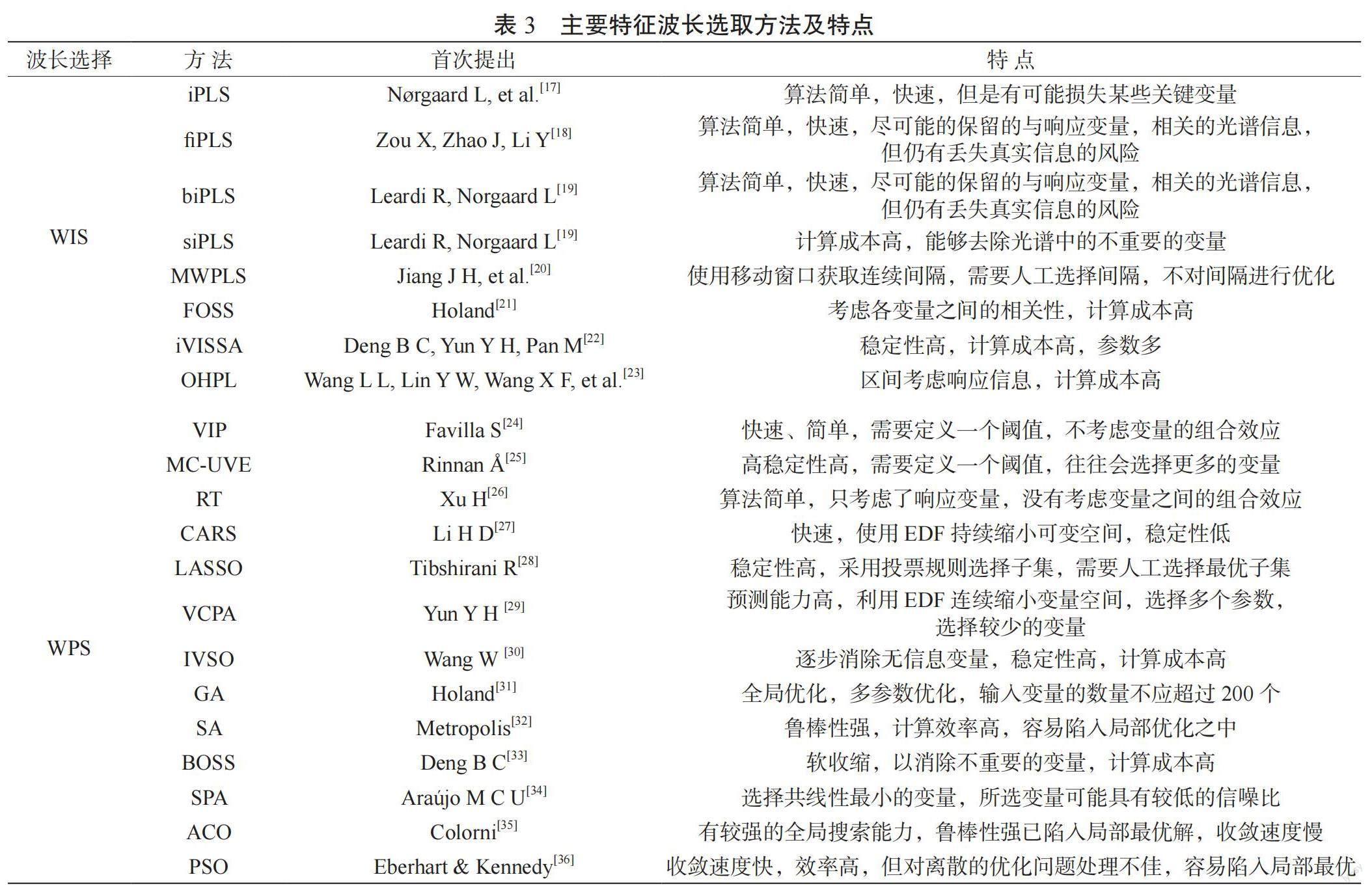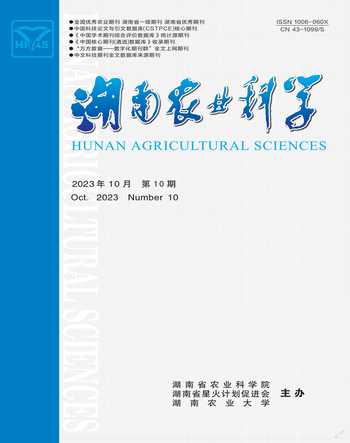近红外光谱技术在木质纤维素定性定量分析中的应用
苗松 李杰 杨玉 李蒙



摘 要:采用传统化学方法对生物质的木质纤维素成分进行分析费时费力,且不能提供生物质的内部结构信息,难以应用于实际的工业生产,近红外光谱技术为木质纤维素成分分析提供了新途径。综述了国内外利用近红外技术进行木质纤维素定性定量分析的研究进展及应用。比较了主要建模样品选择方法的优劣,阐述了人工智能算法结合近红外光谱技术的应用和发展,随着近红外技术的不断发展,它必然会带动能源业、工业、饲料业、造纸业等产业的发展。
关键词:近红外光谱技术;木质纤维素;无损检测;综述
中图分类号:O657.33文献标识码:A文章编号:1006-060X(2023)10-0091-06
Application of Near-Infrared Spectroscopy in Qualitative and Quantitative Analysis of Lignocellulose
MIAO Song1, LI Jie2,3, YANG Yu2,3, LI Meng1
(1. College of Bioscience and Biotechnology, Hunan Agricultural University, Changsha 410128, PRC; 2. Hunan Institute of Agricultural Information and Engineering, Changsha 410125, PRC; 3. Hunan Branch, National Energy R&D Center for Non-Food Biomass, Changsha 410125, PRC)
Abstract:In the field of compositional analysis of lignocellulosic fibers, traditional chemical methods are time-consuming and labor-intensive, unable to provide information about the internal structure of biomass. Their practical applications in industrial production are limited. The emergence of near-infrared spectroscopy (NIRS) has revolutionized this field by offering a rapid, reliable, green, and cost-effective method. This article provides a comprehensive review of the research progress made in the qualitative and quantitative analysis of lignocellulosic fibers using NIRS technology; furthermore, elaborates the advantages and disadvantages of main modeling sample selection methods; lastly, emphasizes the potential benefits of integrating artificial intelligence algorithms with NIRS technology. It is expected that the continuous advancements in NIRS technology will significantly impact industries such as energy, manufacturing, feed production, and papermaking.
Key words:near-infrared spectrometry; lignocellulose; non-destructive testing; review
收稿日期:2023-08-20
基金项目:国家自然科学基金(32000260);博士后科学基金(2020M682566);创新平台与人才计划(2022NK4214);湖南省农业科技创新资金项目(2022CX84-19)
作者简介:苗 松(1986—),男,河北石家庄市人,硕士研究生,主要从事近红外研究。
通信作者:杨 玉,李 蒙
能源在现代工业中不可或缺。木质纤维素生物质是地球上最丰富的可持续碳源,具有巨大的经济价值。它可以通过化学、物理、微生物或酶处理直接或间接地用于生产生物制品,并广泛应用于食品、健康、医药、能源、材料和化学工业等领域[1]。木质纤维素生物质主要由纤维素、半纤维素和木质素组成。已有许多研究报道了使用木质纤维素生产生物燃料和新型材料的方法,这表明木质纤维素生物质具有广阔的发展前景[2-4]。然而,植物中的木质纤维素含量常常因材料類型、生长地点、收获部位和加工方式的不同而产生差异[5,6],而生物质结构成分(纤维素、半纤维素和木质素)的差异导致其化学反应性不同,进而影响工业生产的工艺条件,如温度、反应时间、粒径大小、催化剂种类和比例等[7-9]。因此,快速准确地测定生物质结构成分的含量是加速生物质资源利用的前提[10]。
传统的化学方法如范式洗涤法(Van Soest)等可以得到相关木质纤维素的含量信息,而且已经在实践中得到了证明[11],但是传统的化学方法需要进行繁琐的操作,费时费力,并且结果的精确度不高,而近几年兴起的高效液相色谱法因成本太高难以得到普及。因此急切的需要一种能够快速的、绿色的、低成本的、准确的木质纤维素分析方法[10]。
近红外光谱(NIRS)被广泛应用于农业、食品、医学和中药等领域的定性和定量分析。此外,近红外光谱还被证实可用于木质纤维素的定性和定量分析。近红外光谱技术的优势之一是样品处理简便,能够在短时间内高效处理大量样品,从而降低了分析成本。此外,该技术对样品无损伤,使得样品可以在分析后继续进行其他测试,提高了实验的准确性。与传统的化学方法相比,近红外光谱还能检测和分析生物质样品中的官能团和物理结构,这是传统方法所无法实现的。
主要综述了近红外光谱技术在木质纤维素生物质的定量和定性方面的研究进展以及近红外光谱技术的基本原理,并对其在生物质原料方面上的应用进行了讨论和展望。
1 近红外光谱技术的原理
根据朗伯比尔定律可知,近红外光谱分析中的吸光度与物质在特定波长处的浓度呈线性关系。近红外光谱属于振动光谱,主要是由于组成物质的分子在不停的振动,当近红外光照射时,频率相同的光线和基团就会发生共振现象,光的能量传递给分子。不同的基团拥有不同的能级,因此近红外光谱可以用来进行定性及定量分析。近红外光谱的信息主要由含氢基团的倍频与合频组成,这增加了分析的难度,但随着化学计量学的发展,通过近红外光谱分析物质组成及结构信息已经成为现实[12]。
2 与木质纤维素相关的近红外光谱吸收带
近期研究已经表明,生物质中不同基团之间的近红外吸收带存在高度相关性并且有可能互相重叠,增加了近红外光谱分析的挑战。为了提高模型的准确性,研究人员通常会对光谱进行预处理,并选择其中的特定波长作为构建模型的特征。例如,针对芒草木质纤维素的预测模型,在选择了特定波长后,其预测能力显著提升,相关系数超过0.9,可用于测量纤维素和半纤维素的含量[7]。
3 基于近红外光谱的模型构建及化学计量学应用
近红外光谱分析的关键是建模样品的选择,因为一个具有代表性的样品集应具有足够的方差,在样品选择过程中,应当考虑样品的每个属性以及属性之间的联系。如表1所示,目前常用的代表样品选择方法包括KS方法、SPXY方法、GN距离法及MLIS方法[13]。
近红外光谱分析技术长期以来面临的挑战是近红外光谱区的吸收强度较弱,并且不同基团的倍频和合频吸收带会产生谱带重叠,导致分析困难。然而,近年来,随着近红外光谱仪和化学计量学的快速发展,近红外光谱在各个领域得到了广泛应用。近红外光谱的化学计量学方法研究主要涵盖光谱预处理、特征波长选择和建模方法。光谱预处理包括基线校正、平滑处理和散射校正。特征波长选择则包括波长选择方法(Wavelength Selection, WS)和波段选择方法(Wavelength Interval Selection, WIS)。光谱预处理主要用来消除在光谱测量过程中产生的噪音、杂散光的干扰,和修正基线漂移等。特征波长的选择用于消除光谱中的无关变量,提高模型的准确性,降低模型的复杂度。表2和表3总结了常见的光谱处理方法和主要特征波长选取方法及特点。
4 近红外光谱技术在木质纤维素中的应用
目前关于近红外光谱应用的报道中,绝大部分都是与木质纤维素有关的。在造纸业和化工产业中,近红外光谱除了用来研究茎秆的化学性质之外,为了提升它们的利用效率,还经常用近红外光谱研究其物理性质如结晶度,聚合度等。此外,近红外光谱还常用于预测生物质中的水分、灰分和蛋白质含量。为其更好的加工利用提供了强有力的手段。由于生物质的成分可能因收获时间、地点和品种的不同而异,因此对生物质成分进行实时监控对于工业应用非常重要。近红外光谱与微机电系统(MEMS)的结合已成功实现对单糖含量的在线监测。近红外光谱技术还被用于分析多种藻类原材料,如羊栖菜,并使用支持向量机(SVM)构建了预测甘露醇、多糖、岩藻甾醇和岩藻黄素含量的模型[37]。验证集的R2值最低达到了0.81,最高达到了0.99,说明近红外光谱能够快速准确地表征这些成分。此外,研究还表明近红外光谱对玉米秸秆和芒草秸秆的主要成分具有良好的预测结果。
4.1 近红外在生物质原料定性中的应用
Xiaoli Jin[38]通过结合近红外光谱和化学计量学对3种芒属植物进行了分类预测。基于Line-LSSVR的分类模型在测试集上达到了99.42%的正确率。研究结果表明,近红外光谱结合初步形态分类是一种有效可靠的芒属植物分类方法。类似地,Haiyan Zhao[39]使用类似的方法对中国4个小麦主产区的240个小麦样品进行了分析,并成功实现了对小麦地理位置的溯源,总体正确率达到了85%。此外,皂荚刺作为一种传统中药材,具有高度的药用和经济价值。然而,一些不法商贩经常通过掺杂其他相似枝条的方式冒充皂荚刺以获取利益。为此,Wang等[40]利用近红外光谱提供了一种简单、快速、可靠的辨别方法,其正确率高达99.72%。
4.2 近红外在生物质原料定量中的应用
近红外光谱已被广泛应用于预测生物质的主要成分,并对木质纤维素的组成进行了深入研究。由表4可知,除了大须芒草的PCR模型和橄榄树,其他校正模型的相关系数(R2)均大于0.9,大多数预测模型的相关系数超过0.7。表中的木质素部分总结了近红外光谱在木质素研究中的应用。研究结果显示,尽管使用了不同区间的波长和建模方法,但化学数据与近红外光谱数据之间存在高度相关性,并且具有较高的校正模型预测精度(R2>0.86),预测模型的相关系数存在一定差异。目前,近红外光谱主要应用于监测生物质加工过程中的化学变化,例如木质生物质的酶消化率和植物细胞壁水解效率[41]。
5 問题及展望
近红外光谱技术为生物质分析提供了一种高通量、快速、简便和准确的方法,但在使用时需要注意以下几点。第一,需要精准的化学参考值和高质量的光谱数据;第二,需要一个尽可能大的样品集来构建校正模型;第三,为了适应不同类型的样品,需要提高模型的泛化能力;第四,由于主要含氢基团各种振动的非谐性常数较低(为1.9×10-2),近红外光谱的灵敏度有所限制,通常要求检测的成分含量大于1%;第五,模型需要定期更新,因为它会随着仪器状态或样品的改变而变化。最后,根据朗伯-比尔定律,样品的近红外光吸收值与其化学成分之前存在一定的线性关系,然而,在实际应用中,人们发现非线性回归通常比线性回归获得更好的结果[42,44-45],但非线性模型也面临过度拟合的风险。
前人研究表明,深度学习方法在食品和农产品质量评价中得到了广泛应用,但在木质纤维素领域的应用还相对较少。未来期望将近红外光谱与深度学习相结合,以在木质纤维素的定性和定量分析中取得更深入的应用。这种整合有望提高分析的准确性和效率,进一步推动木质纤维素研究的发展。
参考文献:
[1] ALEJANDRO R,EDUARDO E. Special Issue “Lignocellulosic Biomass”[J]. Molecules, 2021,26(5):1483.
[2] ROUZITALAB Z,MAKLAVANY D M,JAFARINEJAD S,et al. Lignocellulose-based adsorbents:a spotlight review of the effective parameters on carbon dioxide capture process[M]. 2019.
[3] DAI L,HUANG T,JIANG K,et al. A novel recyclable furoic acid-assisted pretreatment for sugarcane bagasse biorefinery in co-production of xylooligosaccharides and glucose[J]. Biotechnology for Biofuels,2020,14(1):35.
[4] CHEN S,XIA Y,ZHANG B,et al. Disassembly of lignocellulose into cellulose, hemicellulose, and lignin for preparation of porous carbon materials with enhanced performances[J]. Journal of Hazardous Materials, 2020, 408:124956.
[5] LABDELLI A,REBIAI A,TAHIRINE M,et al. Nutritional content and antioxidant capacity of the seed and the epicarp in different ecotypes of pistacia atlantica Desf. Subsp. atlantica[J]. Plants,2020, 9(9):1065.
[6] YU HM,ZHANG Z,LI Z,et al. Characteristics of tar formation during cellulose, hemicellulose and lignin gasification[J]. Fuel, 2014, 118:250-256.
[7] 陳晓玲. 基于近红外光谱技术的芒草木质纤维素含量测定方法研究[D]. 浙江大学, 2017.
[8] SOOMRO A,CHEN S,MA S,et al. Elucidation of syngas composition from catalytic steam gasification of lignin,cellulose,actual and simulated biomasses[J]. Biomass and Bioenergy,2018,115:210-222.
[9] GARCIA M A,SALVACHUA D,MARTINEZ M J,et al. Analysis of the relation between the cellulose,hemicellulose and lignin content and the thermal behavior of residual biomass from olive trees[J]. Waste Management,2013,33(11):2245-2249.
[10] VITELLI M,MEHRTASH H,ASSATORY A,et al. Rapid and non-destructive determination of protein and starch content in agricultural powders using near-infrared and fluorescence spectroscopy,and data fusion[J]. Powder Technology,2020,381:620-631.
[11] SOEST P V,RAFFRENATO E,AMBURGH M V. Effect of lignin type on extent and rate of neutral detergent fibre digestion and potential energy yield[J]. South African Journal of Animal Science, 2009, 39(1):61260.
[12] 严衍禄. 近红外光谱分析基础与应用[M].北京:中国轻工业出版社, 2005.
[13] 郭恒光,朱 默,黄敬沁. 喷气燃料近红外光谱建模样本选择方法研究[J]. 山东化工, 2020, 49(24):100-101.
[14] SAVITZKY A,GOLAY M. Smoothing and differentiation of data by simplified least squares procedures[J]. Analytical Chemistry, 1964, 36(8):1627-1639.
[15] BARNES R J,DHANOA M S,SUSAN,et al. Standard normal variate transformation and de-trending of near-infrared diffuse reflectance spectra[J]. Applied Spectroscopy, 1989, 43(5):772-777.
[16] GELADI P,MACDOUGALL D,Martens H. Linearization and scatter-correction for near-infrared reflectance spectra of meat[J]. Applied Spectroscopy,1985,39(3):491-500.
[17] NORGAARD L,SAUDLAND A,Wagner J,et al. Interval partial least-squares regression (iPLS):a comparative chemometric study with an example from near-infrared spectroscopy[J]. 2000,54(3):413-419.
[18] ZOU X,ZHAO J,LI Y. Selection of the efficient wavelength regions in FT-NIR spectroscopy for determination of SSC of `Fuji' apple based on BiPLS and FiPLS models[J]. VIBRATIONAL SPECTROSCOPY, 2007, 44(2):220-227.
[19] LEARDI R,NORGAARD L. Sequential application of backward interval partial least squares and genetic algorithms for the selection of relevant spectral regions[J]. Journal of Chemometrics,2005, 18(11):486-497.
[20] JIANG J H,BERRY R J,SIESLER H W,et al. Wavelength interval selection in multicomponent spectral analysis by moving window partial least-squares regression with applications to mid-infrared and near-infrared spectroscopic data[J]. Analytical Chemistry, 2002, 74(14):3555-3565.
[21] LIN Y W,DENG B C,WANG L L,et al. Fisher optimal subspace shrinkage for block variable selection with applications to NIR spectroscopic analysis[J]. Chemometrics & Intelligent Laboratory Systems,2016,159:196-204.
[22] DENG B C,YUN Y H,PAN M, et al. A new method for wavelength interval selection that intelligently optimizes the locations, widths and combinations of the intervals[J]. The Analyst,2015,140(6):1876-1885.
[23] WANG L L,LIN Y W,WANG X F,et al. A selective review and comparison for interval variable selection in spectroscopic modeling[J]. Chemometrics and Intelligent Laboratory Systems,2018:229-240.
[24] FAVILLA S,DURANTE C,VIGNI M L,et al. Assessing feature relevance in NPLS models by VIP[J]. Chemometrics & Intelligent Laboratory Systems, 2013, 129:76-86.
[25] RINNAN A,ANDERSSON M,AND C R,et al. Recursive weighted partial least squares (rPLS): an efficient variable selection method using PLS[J]. Journal of Chemometrics, 2014, 28(5):439-447.
[26] XU H,LIU Z,CAI W,et al. A wavelength selection method based on randomization test for near-infrared spectral analysis[J]. Chemometrics & Intelligent Laboratory Systems, 2009, 97(2):189-193.
[27] LI H D,LI Y Z,XU Q S. y wavelengths screening using competitive adaptive reweighted sampling method for multivariate calibration[J]. Analytica Chimica Acta,2009,648(1):77-84.
[28] TIBSHIRANI R. Regression shrinkage and selection via the lasso[J]. Journal of the Royal Statistical,1996,58(1):267-288.
[29] YUN Y H,WANG W T,DENG B C,et al. Using variable combination population analysis for variable selection in multivariate calibration[J]. Analytica Chimica Acta, 2015, 862:14-23.
[30] WANG W T,YUN Y H,DENG B C,et al. Iteratively variable subset optimization for multivariate calibration[J]. Rsc Advances,2015, 5(116):95771-95780.
[31] JOHN H H. Adaption in natural and artificial systems[J]. Ann Arbor,1975,6(2):126-137.
[32] MRTROPOLIS N,ROSENBLUTH A W,ROSENBLUTH M N,et al. Equation of state calculations by fast computing machines[J]. The Journal of Chemical Physics,2004,21(6):1087-1092.
[33] DENG B C,YUN H,CAO D S,et al. A bootstrapping soft shrinkage approach for variable selection in chemical modeling[J]. Analytica Chimica Acta, 2016, 908:63-74.
[34] MARIO C U A,TERESA C B S,ROBERTO K H G,et al. The successive projections algorithm for variable selection in spectroscopic multicomponent analysis[J]. Chemometrics and Intelligent Laboratory Systems,2001,57(2):65-73.
[35] COLORNI A,DORIGO M,MANIEZZO V. Distributed optimization by ant colonies [A]. Proc of the first european conference on artificial life[C]. The MIT press,Paris France,1991.
[36] KENNEDY J,EBERHART R. Particle swarm optimization[C].Proceedings of ICNN'95 - International Conference on Neural Networks. IEEE 1995.
[37] YANG Y,TONG H,YANG L,et al. Application of near-infrared spectroscopy and chemometrics for the rapid quality assessment of Sargassum fusiforme[J]. Postharvest Biology and Technology, 2021, 173:111431.
[38] JIN X,CHEN X,LIANG X,et al. Application of visible and near-infrared spectroscopy to classification of Miscanthus species[J]. PLOS ONE,2017,12(4):e0171360.
[39] ZHAO H,GUO B,WEI Y,et al. Near infrared reflectance spectroscopy for determination of the geographical origin of wheat[J]. Food Chemistry,2013,138(2-3):1902-1907.
[40] WANG L,YIN H,JIANG K,et al. Potential of near infrared spectroscopy and pattern recognition for rapid discrimination and quantification of gleditsia sinensis thorn powder with adulterants[J]. Journal of Pharmaceutical & Biomedical Analysis, 2018, 160:64-72.
[41] SHEN H,LI L. Rapid characterization of woody biomass digestibility and chemical composition using near‐infrared spectroscopy free access[J]. Journal of Integrative Plant Biology,2011,53(2):166-175.
[42] JIN X,CHRN X,SHI C,et al. Determination of hemicellulose, cellulose and lignin content using visible and near infrared spectroscopy in miscanthus sinensis[J]. Bioresource Technology,2017,241:603-609.
[43] YAO S,WU G F,Xing M,et al. Determination of lignin content in acacia spp. using near-infrared reflectance spectroscopy [J]. BIORESOURCES,2010,5(2):556-562.
[44] LI X,SUN C,ZHOU B,et al. Determination of hemicellulose,cellulose and lignin in moso bamboo by near infrared spectroscopy[J]. Scientific Reports,2015,5:17210.
[45] 谢 欢. 基于近红外光谱技术的玉米秸秆主要成分含量检测方法研究[D]. 黑龙江八一农垦大学, 2020.
[46] ZHANG K,XU Y,JOHNSON L,et al. Development of near-infrared spectroscopy models for quantitative determination of cellulose and hemicellulose contents of big bluestem[J]. Renewable Energy,2017,109:101-109.
[47] FERNANDEZ J L,SAZE F,CASTRO E,et al. Determination of the Lignocellulosic Components of Olive Tree Pruning Biomass by Near Infrared Spectroscopy[J]. Energies, 2019,12(13):1-10.
[48] 姜 伟,韩光亭,张元明,等. 基于近红外技术的苎麻纤维素及胶质含量快速测定[J]. 纺织学报, 2012, 33(1):6-10.
[49] 段焰青,孔祥勇,李青青,等. 近红外光谱法预测烟草中的纤维素含量[J]. 烟草科技, 2006(8):16-20.
[50] 管丽媛, 王 钟, 祁 宁, 等. 基于近红外光谱技术的亚麻纤维化学成分含量快速测定[J]. 分析测试学报,2020,39(6):795-799.
[51] PAYNE C E,WOLFRUM E J. Rapid analysis of composition and reactivity in cellulosic biomass feedstocks with near-infrared spectroscopy[J]. Biotechnology for Biofuels,2015, 8(1):1-14.
[52] CHEN S F,DANAO M,SINGH V,et al. Determining sucrose and glucose levels in dual-purpose sorghum stalks by Fourier transform near infrared(FT-NIR) spectroscopy[J]. J Sci Food Agric,2014,94(12):2569-2576.
[53] RAMNBO,KD M,ALVES,et al. Multivariate analysis of coconut residues by near infrared spectroscopy[J]. Talanta:The International Journal of Pure and Applied Analytical Chemistry,2015,138:263-272.
[54] MASITHOH R E,AMANAH H Z,YOON W S,et al. Determination of protein and glucose of tuber and root flours using NIR and MIR spectroscopy[J]. Infrared Physics & Technology,2020,113:103577.
(責任编辑:高国赋)

